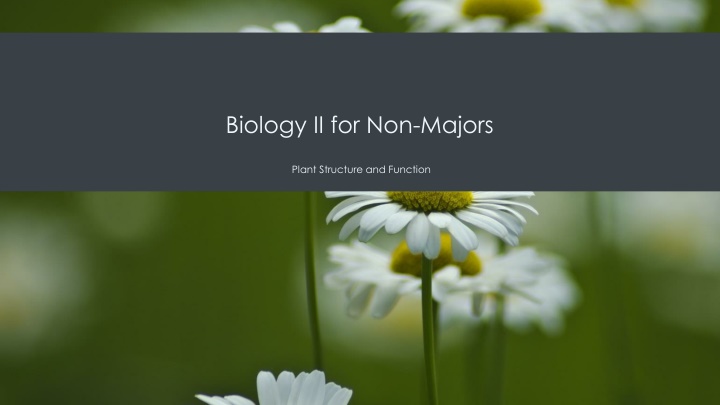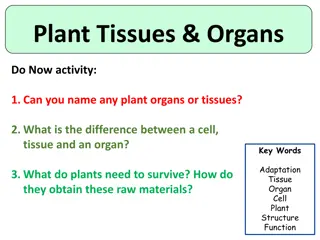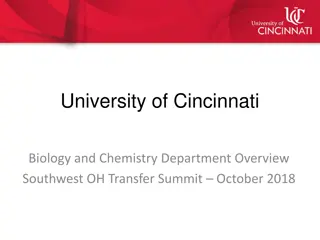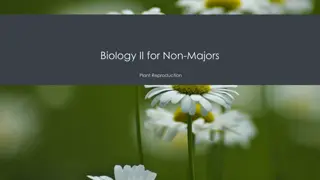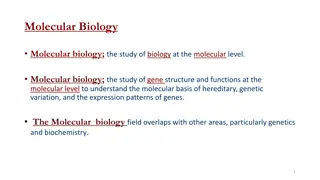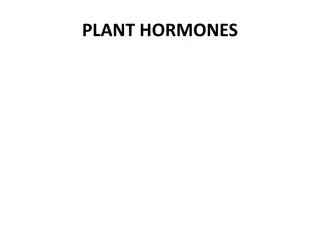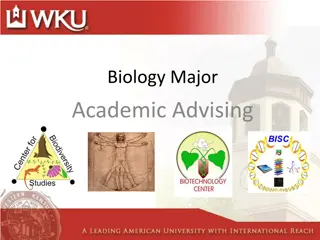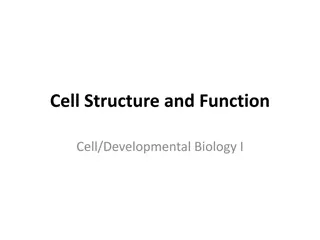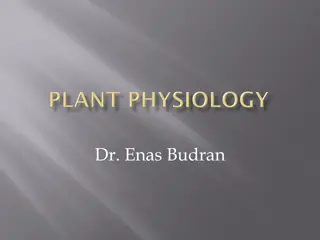Plant Structure and Function in Biology II for Non-Majors
Explore the intricate world of plant cells and tissues in Biology II for Non-Majors. Learn about the different types of plant cells - parenchymal, collenchymal, and sclerenchymal - each with unique structures and functions. Delve into the diverse plant tissue systems, from meristematic tissue for growth to permanent tissue for specialized roles like protection, transport, and support.
Download Presentation

Please find below an Image/Link to download the presentation.
The content on the website is provided AS IS for your information and personal use only. It may not be sold, licensed, or shared on other websites without obtaining consent from the author.If you encounter any issues during the download, it is possible that the publisher has removed the file from their server.
You are allowed to download the files provided on this website for personal or commercial use, subject to the condition that they are used lawfully. All files are the property of their respective owners.
The content on the website is provided AS IS for your information and personal use only. It may not be sold, licensed, or shared on other websites without obtaining consent from the author.
E N D
Presentation Transcript
Biology II for Non-Majors Plant Structure and Function
Types of Plant Cells: Parenchymal Structure Functions Example cube-shaped loosely packed thin-walled relatively unspecialized contain chloroplasts photosynthesis cellular respiration storage food storage tissues of potatoes
Collenchymal Structure Function Example elongated irregularly thickened walls support wind resistance strings running through a stalk of celery
Sclerenchymal Structure Function Example very thick cell walls containing lignin tough fibers in jute (used to make rope) support strength
Plant Tissue Types Plant tissue systems fall into one of two general types: meristematic tissue and permanent (or non- meristematic) tissue. Cells of the meristematic tissue are found in meristems, which are plant regions of continuous cell division and growth. Meristematic tissue cells are either undifferentiated or incompletely differentiated. They continue to divide and contribute to the growth of the plant. In contrast, permanent tissue consists of plant cells that are no longer actively dividing.
Meristematic Tissue Types Meristematic tissues consist of three types, based on their location in the plant: Apical meristems contain meristematic tissue located at the tips of stems and roots, which enable a plant to extend in length. Lateral meristems facilitate growth in thickness or girth in a maturing plant. Intercalary meristems occur only in monocots, at the bases of leaf blades and at nodes (the areas where leaves attach to a stem). This tissue enables the monocot leaf blade to increase in length from the leaf base
Permanent Tissue Types Cells take on specific roles and lose their ability to divide further. They differentiate into three main types: Dermal tissue covers and protects the plant. Vascular tissue transports water, minerals, and sugars to different parts of the plant. Ground tissue serves as a site for photosynthesis, provides a supporting matrix for the vascular tissue, and helps to store water and sugars.
Dermal Tissue The dermal tissue of the stem consists primarily of epidermis, a single layer of cells covering and protecting the underlying tissue. Woody plants have a tough, waterproof outer layer of cork cells commonly known as bark, which further protects the plant from damage. Epidermal cells are the most numerous and least differentiated of the cells in the epidermis. Trichomes are hair-like structures on the epidermal surface. They help to reduce transpiration (the loss of water by aboveground plant parts), increase solar reflectance, and store compounds that defend the leaves against predation by herbivores.
Xylem Tissue Xylem tissue has three types of cells: xylem parenchyma, tracheids, and vessel elements. The latter two types conduct water and are dead at maturity. Tracheids are xylem cells with thick secondary cell walls that are lignified. Water moves from one tracheid to another through regions on the side walls known as pits, where secondary walls are absent. Vessel elements are xylem cells with thinner walls; they are shorter than tracheids. Each vessel element is connected to the next by means of a perforation plate at the end walls of the element. Water moves through the perforation plates to travel up the plant.
Phloem Tissue Phloem tissue is composed of sieve-tube cells, companion cells, phloem parenchyma, and phloem fibers. A series of sieve-tube cells (also called sieve-tube elements) are arranged end to end to make up a long sieve tube, which transports organic substances such as sugars and amino acids. The sugars flow from one sieve-tube cell to the next through perforated sieve plates, which are found at the end junctions between two cells. Although still alive at maturity, the nucleus and other cell components of the sieve-tube cells have disintegrated. Companion cells are found alongside the sieve-tube cells, providing them with metabolic support. The companion cells contain more ribosomes and mitochondria than the sieve-tube cells, which lack some cellular organelles.
Ground Tissue Ground tissue is mostly made up of parenchyma cells, but may also contain collenchyma and sclerenchyma cells that help support the stem. The ground tissue towards the interior of the vascular tissue in a stem or root is known as pith, while the layer of tissue between the vascular tissue and the epidermis is known as the cortex.
Plant Organs Vascular plants have two distinct organ systems: a shoot system, and a root system. The shoot system consists of two portions: the vegetative (non-reproductive) parts of the plant, such as the leaves and the stems, and the reproductive parts of the plant, which include flowers and fruits. The shoot system generally grows above ground, where it absorbs the light needed for photosynthesis. The root system, which supports the plants and absorbs water and minerals, is usually underground.
Plant Organs (cont.)
Stems Stems provide support to the plant, holding leaves, flowers and buds; in some cases, stems also store food for the plant. The stem of the plant connects the roots to the leaves, helping to transport absorbed water and minerals to different parts of the plant. It also helps to transport the products of photosynthesis, from the leaves to the rest of the plant.
Stem Structure Leaves are attached to the plant stem at areas called nodes. An internode is the stem region between two nodes. The petiole is the stalk connecting the leaf to the stem. The leaves just above the nodes arose from axillary buds.
Parenchyma Cells Parenchyma cells, the most common plant cells, are found in the stem, the root, the inside of the leaf, and the pulp of the fruit. They are responsible for metabolic functions, such as photosynthesis, and they help repair and heal wounds. Some also store starch.
Collenchyma Cells Collenchyma cells are elongated cells with unevenly thickened walls. They provide structural support, mainly to the stem and leaves. These cells are alive at maturity and are usually found below the epidermis.
Sclerenchyma cells Sclerenchyma cells also provide support to the plant, but unlike collenchyma cells, many of them are dead at maturity. They have secondary cell walls that are thickened with deposits of lignin, an organic compound that is a key component of wood. There are two types of sclerenchyma cells: fibers and sclereids.
Leaves Leaves are the main sites for photosynthesis: the process by which plants synthesize food. Most leaves are usually green, due to the presence of chlorophyll in the leaf cells. Some leaves may have different colors, caused by other plant pigments that mask the green chlorophyll. The thickness, shape, and size of leaves are adapted to the environment. Each variation helps a plant species maximize its chances of survival in a particular habitat.
Parts of a Leaf
Leaf Arrangement The arrangement of leaves on a stem, known as phyllotaxy, enables maximum exposure to sunlight. Each plant species has a characteristic leaf arrangement and form. The pattern of leaf arrangement may be alternate, opposite, or spiral.
Leaf Structure Leaf tissue consists of the epidermis, which forms the outermost cell layer, and mesophyll and vascular tissue, which make up the inner portion of the leaf.
Root Growth and Structure
Root Modifications: Vegetables Root structures may be modified for specific purposes. Some roots are bulbous and store starch. Tap roots, such as carrots, turnips, and beets, are examples of roots that are modified for food storage.
Water Potential Plants use the potential energy in water to move water and solutes from one part of the plant to another. The water potential in plant solutions is influenced by solute concentration, pressure, gravity, and factors called matrix effects.
Transpiration Transpiration is the loss of water from the plant through evaporation at the leaf surface. It is the main driver of water movement in the xylem. Transpiration is caused by the evaporation of water at the leaf atmosphere interface; water from the roots is pulled up by this tension. At night, when stomata shut and transpiration stops, the water is held in the stem and leaf by the adhesion of water to the cell walls of the xylem vessels and tracheids, and the cohesion of water molecules to each other. Transpiration is a passive process; it does not use ATP.
Cohesion-tension Theory of Sap Ascent
Phloem Phloem is comprised of cells called sieve-tube elements. Phloem sap travels through perforations called sieve tube plates. Neighboring companion cells carry out metabolic functions for the sieve-tube elements and provide them with energy. Lateral sieve areas connect the sieve- tube elements to the companion cells.
Translocation Sucrose is actively transported from source cells into companion cells and then into the sieve- tube elements. This reduces the water potential, which causes water to enter the phloem from the xylem. The resulting positive pressure forces the sucrose-water mixture down toward the roots, where sucrose is unloaded. Transpiration causes water to return to the leaves through the xylem vessels.
Phototropism Phototropism the directional bending of a plant toward or away from a light source is a response to blue wavelengths of light. Positive phototropism is growth towards a light source, while negative phototropism (also called skototropism) is growth away from light. Phototropins are protein-based receptors responsible for mediating the phototropic response. Like all plant photoreceptors, phototropins consist of a protein portion and a light-absorbing portion, called the chromophore. Other responses under the control of phototropins are leaf opening and closing, chloroplast movement, and the opening of stomata.
Other Photo-responses Photomorphogenesis is the growth and development of plants in response to light. It allows plants to optimize their use of light and space. Photoperiodism is the ability to use light to track time. Plants can tell the time of day and time of year by sensing and using various wavelengths of sunlight.
Plant Responses to Gravity Whether or not they germinate in the light or in total darkness, shoots usually sprout up from the ground, and roots grow downward into the ground. A plant laid on its side in the dark will send shoots upward when given enough time. Gravitropism ensures that roots grow into the soil and that shoots grow toward sunlight. Growth of the shoot apical tip upward is called negative gravitropism. Growth of the roots downward is called positive gravitropism.
How Do Plants Sense Gravity? Amyloplasts are specialized plastids that contain starch granules and settle downward in response to gravity. Amyloplasts are found in shoots and in specialized cells of the root cap. When amyloplasts settle to the bottom of the gravity-sensing cells in the root or shoot, they physically contact the endoplasmic reticulum (ER), causing the release of calcium ions from inside the ER. This calcium signaling in the cells causes polar transport of the plant hormone IAA to the bottom of the cell. In roots, a high concentration of IAA inhibits cell elongation. The effect slows growth on the lower side of the root, while cells develop normally on the upper side. IAA has the opposite effect in shoots.
Responses to Touch and Wind The movement of a plant subjected to constant directional pressure is called thigmotropism. A thigmonastic response is a touch response independent of the direction of stimulus. Thigmomorphogenesis is a slow developmental change in the shape of a plant subjected to continuous mechanical stress. When trees bend in the wind, for example, growth is usually stunted and the trunk thickens.
Plant Defense The first line of defense in plants is an intact and impenetrable barrier. Bark and the waxy cuticle can protect against predators. Other adaptations against herbivory include thorns, which are modified branches, and spines, which are modified leaves. They discourage animals by causing physical damage and inducing rashes and allergic reactions. A plant s exterior protection can be compromised by mechanical damage, which may provide an entry point for pathogens.
Secondary Metabolites If the first line of defense is breached, the plant must resort to a different set of defense mechanisms, such as toxins and enzymes. Secondary metabolites are compounds that are not directly derived from photosynthesis and are not necessary for respiration or plant growth and development. Many metabolites are toxic, and can even be lethal to animals that ingest them. Some metabolites are alkaloids, which discourage predators with noxious odors or repellent tastes. Other alkaloids affect herbivores by causing either excessive stimulation or lethargy. Some compounds become toxic after ingestion.
